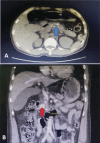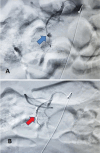Superior pancreaticoduodenal artery pseudoaneurysm with subsequent hemosuccus pancreaticus: an unusual complication of chronic pancreatitis
- PMID: 39712553
- PMCID: PMC11661550
- DOI: 10.22551/2024.45.1104.10301
Superior pancreaticoduodenal artery pseudoaneurysm with subsequent hemosuccus pancreaticus: an unusual complication of chronic pancreatitis
Abstract
The development of an arterial pseudoaneurysm is an unusual complication of chronic pancreatitis. The most commonly involved artery is the splenic artery. This is a case report describing a case of a superior pancreaticoduodenal artery pseudoaneurysm in a patient with chronic pancreatitis who developed hemosuccus pancreaticus. A 46-year-old man with history of binge ethanol intake presented to the emergency department with abdominal pain. A computed tomography (CT) scan showed features of chronic pancreatitis along with a 2 x 1.8 cm enhancing mass at the level of the pancreatic head, consistent with an arterial pseudoaneurysm in close proximity to the pancreatic duct as confirmed on endoscopic ultrasound. He underwent an endoscopic retrograde cholangiopancreatography in the context of a rise in his liver enzymes with the presence of gallbladder sludge. This was complicated by hemosuccus pancreaticus, which was successfully managed with percutaneous angioembolization. Despite its unusual incidence, pseudoaneurysm remains an important complication of chronic pancreatitis with a high mortality rate in case of acute hemorrhage. Diagnostic modalities include abdominal CT and Color Doppler ultrasound. Endovascular techniques are considered to be the first line of therapy in most cases. Early recognition and management of pancreatic pseudoaneurysms is important to avoid life-threatening hemorrhage.
Keywords: angioembolization; chronic pancreatitis; pseudoaneurysm; superior pancreaticoduodenal artery.
Conflict of interest statement
The authors declare that they have no competing interest.
Figures



Similar articles
-
Hemosuccus pancreaticus from superior mesenteric artery pseudoaneurysm within perceived pancreatic mass.Clin J Gastroenterol. 2019 Feb;12(1):88-91. doi: 10.1007/s12328-018-0899-4. Epub 2018 Aug 28. Clin J Gastroenterol. 2019. PMID: 30155834
-
Two cases of hemosuccus pancreaticus in which hemostasis was achieved by transcatheter arterial embolization.J Hepatobiliary Pancreat Surg. 2003;10(6):450-4. doi: 10.1007/s00534-003-0841-z. J Hepatobiliary Pancreat Surg. 2003. PMID: 14714167
-
Asymptomatic and early pseudoaneurysm of posterior superior pancreaticoduodenal artery and right gastric artery complicating acute pancreatitis: A case report.Int J Surg Case Rep. 2016;28:344-347. doi: 10.1016/j.ijscr.2016.10.036. Epub 2016 Oct 18. Int J Surg Case Rep. 2016. PMID: 27783984 Free PMC article.
-
Hemosuccus Pancreaticus: A Comprehensive Review of Presentation Patterns, Diagnostic Approaches, Therapeutic Strategies, and Clinical Outcomes.J Investig Med High Impact Case Rep. 2022 Jan-Dec;10:23247096211070388. doi: 10.1177/23247096211070388. J Investig Med High Impact Case Rep. 2022. PMID: 35045737 Free PMC article. Review.
-
Hemosuccus pancreaticus complicating chronic pancreatitis: an obscure cause of upper gastrointestinal bleeding.Langenbecks Arch Surg. 2000 Mar;385(2):124-8. doi: 10.1007/s004230050254. Langenbecks Arch Surg. 2000. PMID: 10796050 Review.
References
-
- Hoilat GJ, Mathew G, Ahmad H. StatPearls [Internet] Treasure Island (FL): StatPearls Publishing; 2024 Jan-. Pancreatic Pseudoaneurysm. [Updated 2023 Jul 17] [Available from: https://www.ncbi.nlm.nih.gov/sites/books/NBK430937/, at 3/12/2024] - PubMed
Publication types
LinkOut - more resources
Full Text Sources
